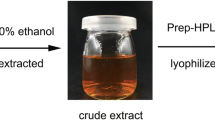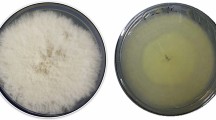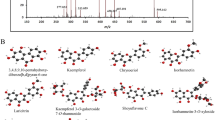Abstract
Adenostemma lavenia (L.) Kuntze (Asteraceae) is widely distributed in tropical regions of East Asia, and both A. lavenia and A. madurense (DC) are distributed in Japan. In China and Taiwan, A. lavenia is used as a folk medicine for treating lung congestion, pneumonia, and hepatitis. However, neither phylogenic nor biochemical analysis of this plants has been performed to date. We have reported that the aqueous extract of Japanese A. lavenia contained high levels of ent-11α-hydroxy-15-oxo-kaur-16-en-19-oic acid (11αOH-KA; a kaurenoic acid), which is a potent anti-melanogenic compound. Comparison of chloroplast DNA sequences suggested that A. lavenia is originated from A. madurense. Analyses of kaurenoic acids revealed that Japanese A. lavenia and A. madurense contained high levels of 11αOH-KA and moderate levels of 11α,15OH-KA, while Taiwanese A. lavenia mainly contained 9,11αOH-KA. The diverse biological activities (downregulation of Tyr, tyrosinase, gene expression [anti-melanogenic] and iNOS, inducible nitric oxide synthase, gene expression [anti-inflammatory], and upregulation of HO-1, heme-oxygenase, gene expression [anti-oxidative]) were associated with 11αOH-KA and 9,11αOH-KA but not with 11α,15OH-KA. Additionally, 11αOH-KA and 9,11αOH-KA decreased Keap1 (Kelch-like ECH-associated protein 1) protein levels, which was accompanied by upregulation of protein level and transcriptional activity of Nrf2 (NF-E2-related factor-2) followed by HO-1 gene expression. 11αOH-KA and 9,11αOH-KA differ from 11α,15OH-KA in terms of the presence of a ketone (αβ-unsaturated carbonyl group, a thiol modulator) at the 15th position; therefore, thiol moieties on the target proteins, including Keap1, may be important for the biological activities of 11αOH-KA and 9,11αOH-KA and A. lavenia extract.
Graphic abstract





Similar content being viewed by others
References
Cos P, Vlietinck AJ, Berghe DV, Maes L (2006) Anti-infective potential of natural products: how to develop a stronger in vitro “proof-of-concept.” J Ethnopharmacol 106:290–302. https://doi.org/10.1016/j.jep.2006.04.003
Duraipandiyan V, Ayyanar M, Ignacimuthu S (2006) Antimicrobial activity of some ethnomedicinal plants used by Paliyar tribe from Tamil Nadu, India. BMC Complement Altern Med 6:35. https://doi.org/10.1186/1472-6882-6-35
Chen GG, Leung J, Liang NC, Li L, Wu K, Chan UP, Leung BC, Li M, Du J, Deng YF, Gong X, Lv Y, Chak EC, Lai PB (2012) Ent-11α-hydroxy-15-oxo-kaur-16-en-19-oic-acid inhibits hepatocellular carcinoma in vitro and in vivo via stabilizing IkBα. Invest New Drugs 30:2210–2218. https://doi.org/10.1007/s10637-011-9791-5
Hamamoto A, Isogai R, Maeda M, Hayazaki M, Horiyama E, Takashima S, Koketsu M, Takemori H (2020) The high content of Ent-11α-hydroxy-15-oxo-kaur- 16-en-19-oic Acid in Adenostemma lavenia (L.) O. Kuntze leaf extract: with preliminary in vivo assays. Foods 9:73. https://doi.org/10.3390/foods9010073
Kuroi A, Sugimura K, Kumagai A, Kohara A, Nagaoka Y, Kawahara H, Yamahara M, Kawahara N, Takemori H, Fuchino H (2017) The importance of 11α-OH, 15-oxo, and 16-en Moieties of 11α-Hydroxy-15-oxo-kaur-16-en-19-oic acid in its inhibitory activity on melanogenesis. Skin Pharmacol Physiol 30:205–215. https://doi.org/10.1159/000475471
Wu K, Liu Y, Lv Y, Cui L, Li W, Chen J, Liang NC, Li L (2013) Ent-11α-hydroxy-15-oxo-kaur-16-en-19-oic-acid induces apoptosis and cell cycle arrest in CNE-2Z nasopharyngeal carcinoma cells. Oncol Rep 29:2101–2108. https://doi.org/10.3892/or.2013.2375
Ye H, Wu Q, Guo M, Wu K, Lv Y, Yu F, Liu Y, Gao X, Zhu Y, Cui L, Liang N, Yun T, Li L, Zheng X (2016) Growth inhibition effects of ent-11α-hydroxy-15-oxo-kaur-16-en-19-oic-acid on colorectal carcinoma cells and colon carcinoma-bearing mice. Mol Med Rep 13:3525–3532. https://doi.org/10.3892/mmr.2016.4950
Shimizu S, Miyase T, Umehara K, Ueno A (1990) Kaurane-type diterpenes from Adenostemma lavenia O. Kuntze. Chem Pharm Bull 38:1308–1312
Lyu JH, Lee GS, Kim KH, Kim HW, Cho SI, Jeong SI, Kim HJ, Ju YS, Kim HK, Sadikot RT, Christman JW, Oh SR, Lee HK, Ahn KS, Joo M (2011) ent-kaur-16-en-19-oic Acid, isolated from the roots of Aralia continentalis, induces activation of Nrf2. J Ethnopharmacol 137:1442–1449. https://doi.org/10.1016/j.jep.2011.08.024
Kim KH, Sadikot RT, Joo M (2016) Therapeutic effect of ent-kaur-16-en-19-oic acid on neutrophilic lung inflammation and sepsis is mediated by Nrf2. Biochem Biophys Res Commun 474:534–540. https://doi.org/10.1016/j.bbrc.2016.04.122
Nathan C (1992) Nitric oxide as a secretory product of mammalian cells. Faseb J 6:3051–3064
Kim HK, Cheon BS, Kim YH, Kim SY, Kim HP (1999) Effects of naturally occurring flavonoids on nitric oxide production in the macrophage cell line RAW 264.7 and their structure-activity relationships. Biochem Pharmacol 58:759–765. https://doi.org/10.1016/s0006-2952(99)00160-4
Spiller F, Oliveira Formiga R, da Silva F, Coimbra J, Alves-Filho JC, Cunha TM, Cunha FQ (2019) Targeting nitric oxide as a key modulator of sepsis, arthritis and pain. Nitric Oxide 89:32–40. https://doi.org/10.1016/j.niox.2019.04.011
Choi RJ, Shin EM, Jung HA, Choi JS, Kim YS (2011) Inhibitory effects of kaurenoic acid from Aralia continentalis on LPS-induced inflammatory response in RAW264.7 macrophages. Phytomedicine 18:677–682. https://doi.org/10.1016/j.phymed.2010.11.010
Taguchi K, Motohashi H, Yamamoto M (2011) Molecular mechanisms of the Keap1–Nrf2 pathway in stress response and cancer evolution. Genes Cells 16:123–140. https://doi.org/10.1111/j.1365-2443.2010.01473.x
Kobayashi EH, Suzuki T, Funayama R, Nagashima T, Hayashi M, Sekine H, Tanaka N, Moriguchi T, Motohashi H, Nakayama K, Yamamoto M (2016) Nrf2 suppresses macrophage inflammatory response by blocking proinflammatory cytokine transcription. Nat Commun 7:11624. https://doi.org/10.1038/ncomms11624
Cuadrado A, Manda G, Hassan A, Alcaraz MJ, Barbas C, Daiber A, Ghezzi P, León R, López MG, Oliva B, Pajares M, Rojo AI, Robledinos-Antón N, Valverde AM, Guney E, Schmidt H (2018) Transcription factor NRF2 as a therapeutic target for chronic diseases: a systems medicine approach. Pharmacol Rev 70:348–383. https://doi.org/10.1124/pr.117.014753
Batubara I, Astuti RI, Prastya ME, Ilmiawati A, Maeda M, Suzuki M, Hamamoto A, Takemori H (2020) The antiaging effect of active fractions and Ent-11α-Hydroxy-15-Oxo-Kaur-16-En-19-Oic acid isolated from Adenostemma lavenia (L.) O. Kuntze at the cellular level. Antioxidants (Basel). https://doi.org/10.3390/antiox9080719
Tanaka N, Murakami T, Saiki Y, Chen C, Gomez PLD (1981) Chemical and chemotaxonomical studies of ferns. XXXVI. chemical studies on the constituents of costa rican ferns. Chem Pharm Bull 29:3455–3463
Murakami T, Iida H, Tanaka N, Saiki Y, Chen C, Iitaka Y (1981) Chemische und chemotaxonomische Untersuchungen von Filices. XXXIII. Chemische Untersuchungen der Inhaltsstoffe von Pteris longipes DON. Chem Pharm Bull 29:657–662
Isogawa K, Asano M, Hayazaki M, Koga K, Watanabe M, Suzuki K, Kobayashi T, Kawaguchi K, Ishizuka A, Kato S, Ito H, Hamamoto A, Koyama H, Furuta K, Takemori H (2021) Thioxothiazolidin derivative, 4-OST, inhibits melanogenesis by enhancing the specific recruitment of tyrosinase-containing vesicles to lysosome. J Cell Biochem 122:667–678. https://doi.org/10.1002/jcb.29895
Sanosaka M, Fujimoto M, Ohkawara T, Nagatake T, Itoh Y, Kagawa M, Kumagai A, Fuchino H, Kunisawa J, Naka T, Takemori H (2015) Salt-inducible kinase 3 deficiency exacerbates lipopolysaccharide-induced endotoxin shock accompanied by increased levels of pro-inflammatory molecules in mice. Immunology 145:268–278. https://doi.org/10.1111/imm.12445
Momozane T, Kawamura T, Itoh Y, Sanosaka M, Sasaki T, Kanzaki R, Ose N, Funaki S, Shintani Y, Minami M, Okumura M, Takemori H (2018) Carnosol suppresses interleukin-6 production in mouse lungs injured by ischemia-reperfusion operation and in RAW264.7 macrophages treated with lipopolysaccharide. Biochem Cell Biol 96:769–776. https://doi.org/10.1139/bcb-2017-0339
Do HDK, Jung J, Hyun JY, Yoon SJ, Lim C, Park K, Kim JH (2019) The newly developed single nucleotide polymorphism (SNP) markers for a potentially medicinal plant, Crepidiastrum denticulatum (Asteraceae), inferred from complete chloroplast genome data. Mol Biol Rep 46:3287–3297. https://doi.org/10.1007/s11033-019-04789-5
Herraiz C, Martínez-Vicente I, Maresca V (2021) The α-melanocyte-stimulating hormone/melanocortin-1 receptor interaction: A driver of pleiotropic effects beyond pigmentation. Pigment Cell Melanoma Res. https://doi.org/10.1111/pcmr.12980
Shin JM, Kim MY, Sohn KC, Jung SY, Lee HE, Lim JW, Kim S, Lee YH, Im M, Seo YJ, Kim CD, Lee JH, Lee Y, Yoon TJ (2014) Nrf2 negatively regulates melanogenesis by modulating PI3K/Akt signaling. PLoS ONE 9:e96035. https://doi.org/10.1371/journal.pone.0096035
Yamahara M, Sugimura K, Kumagai A, Fuchino H, Kuroi A, Kagawa M, Itoh Y, Kawahara H, Nagaoka Y, Iida O, Kawahara N, Takemori H, Watanabe H (2016) Callicarpa longissima extract, carnosol-rich, potently inhibits melanogenesis in B16F10 melanoma cells. J Nat Med 70:28–35. https://doi.org/10.1007/s11418-015-0933-5
Khor TO, Huang MT, Kwon KH, Chan JY, Reddy BS, Kong AN (2006) Nrf2-deficient mice have an increased susceptibility to dextran sulfate sodium-induced colitis. Cancer Res 66:11580–11584. https://doi.org/10.1158/0008-5472.can-06-3562
Johnson DA, Amirahmadi S, Ward C, Fabry Z, Johnson JA (2010) The absence of the pro-antioxidant transcription factor Nrf2 exacerbates experimental autoimmune encephalomyelitis. Toxicol Sci 114:237–246. https://doi.org/10.1093/toxsci/kfp274
Hueso-Falcón I, Cuadrado I, Cidre F, Amaro-Luis JM, Ravelo ÁG, Estevez-Braun A, De Las HB, Hortelano S (2011) Synthesis and anti-inflammatory activity of ent-kaurene derivatives. Eur J Med Chem 46:1291–1305. https://doi.org/10.1016/j.ejmech.2011.01.052
Kim KH, Han JW, Jung SK, Park BJ, Han CW, Joo M (2017) Kaurenoic acid activates TGF-β signaling. Phytomedicine 32:8–14. https://doi.org/10.1016/j.phymed.2017.04.008
Dong T, Liu W, Shen Z, Li L, Chen S, Lei X (2016) Pterisolic Acid B is a Nrf2 Activator by Targeting C171 within Keap1-BTB Domain. Sci Rep 6:19231. https://doi.org/10.1038/srep19231
Malhotra D, Portales-Casamar E, Singh A, Srivastava S, Arenillas D, Happel C, Shyr C, Wakabayashi N, Kensler TW, Wasserman WW, Biswal S (2010) Global mapping of binding sites for Nrf2 identifies novel targets in cell survival response through ChIP-Seq profiling and network analysis. Nucleic Acids Res 38:5718–5734. https://doi.org/10.1093/nar/gkq212
Yasumoto K, Yokoyama K, Shibata K, Tomita Y, Shibahara S (1994) Microphthalmia-associated transcription factor as a regulator for melanocyte-specific transcription of the human tyrosinase gene. Mol Cell Biol 14:8058–8070
Lin YH, Lin YJ, Chang TH, Chang YH, Lim YP, Chung JG, Hsieh WT (2020) Pipoxolan suppresses the inflammatory factors of NF-κB, AP-1, and STATs, but activates the antioxidative factor Nrf2 in LPS-stimulated RAW 264.7 murine macrophage cells. Environ Toxicol 35:1352–1363. https://doi.org/10.1002/tox.23000
Tran-Thi TA, Decker K, Baeuerle PA (1995) Differential activation of transcription factors NF-ϰB and AP-1 in rat liver macrophages. Hepatology 22:613–619. https://doi.org/10.1002/hep.1840220235
Acknowledgements
We thank Mr. Hideki Ohtsuka, a member of the Nature Environment Advisor of Gifu City, for his selection of A. lavenia. This study supported by the Japan Society for The Promotion of Science (JSPS: No. JPJSBP120218102 and 20KK0125) and Gifu University (Acceleration program and Start-up Eco-System).
Author information
Authors and Affiliations
Contributions
MM (Maeda), MS, HF, NK, TK, MM (Matsuno), NK, and AH performed experiments. IM, DI, MK analyzed data. MM (Matsuno) identified A. madurense.
MM (Maeda) and HT wrote the manuscript.
Corresponding author
Ethics declarations
Conflict of interest
The authors declare that we have no known competing financial interests.
Additional information
Publisher's Note
Springer Nature remains neutral with regard to jurisdictional claims in published maps and institutional affiliations.
Supplementary Information
Below is the link to the electronic supplementary material.
Rights and permissions
About this article
Cite this article
Maeda, M., Suzuki, M., Fuchino, H. et al. Diversity of Adenostemma lavenia, multi-potential herbs, and its kaurenoic acid composition between Japan and Taiwan. J Nat Med 76, 132–143 (2022). https://doi.org/10.1007/s11418-021-01565-3
Received:
Accepted:
Published:
Issue Date:
DOI: https://doi.org/10.1007/s11418-021-01565-3




